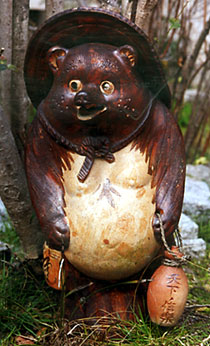| /
travel & nightlife / japan part 1 á love hotels á the wa á sexual history á kabuki-cho á manga, movies and pervert shops á copping a feel á support dating á |
 Absent the Puritan roots that have shackled American sex life since Jamestown, modern Japan comes from a pagan Shinto-Buddhist background that once encouraged raucous fertility festivals and the placement of dosojin -- "roadside deities" originally shaped like squat phalli and vulvas -- near thoroughfares to protect travelers. Far from discouraging illicit trysts, religion elevated them into a joyous way of continuing the race. Largely, sex was, and is, thought of as a natural part of human existence. To illustrate, Nicholas Bornoff's Pink Samurai quotes the mid-seventh century Chinese writer Li Tung-Hsuan's Art of the Bedchamber: Absent the Puritan roots that have shackled American sex life since Jamestown, modern Japan comes from a pagan Shinto-Buddhist background that once encouraged raucous fertility festivals and the placement of dosojin -- "roadside deities" originally shaped like squat phalli and vulvas -- near thoroughfares to protect travelers. Far from discouraging illicit trysts, religion elevated them into a joyous way of continuing the race. Largely, sex was, and is, thought of as a natural part of human existence. To illustrate, Nicholas Bornoff's Pink Samurai quotes the mid-seventh century Chinese writer Li Tung-Hsuan's Art of the Bedchamber:
"Of all the things that make man prosper, none can be compared to sexual intercourse. It is modeled after heaven and takes its pattern by earth; it regulates yin and rules yang. Those who understand its significance can nurture their nature and prolong their years; those who miss its true meaning will harm themselves and die before their time." In medieval Japan, if a spring planting celebration ended with village-wide poking in the paddies, no one raised an eyebrow. Male villagers often found sex partners and future wives through yobai, "night creeping," when enterprising studs stole into the homes of village girls in pitch darkness to perform the earliest recorded booty calls. Surprisingly, parents knew of and subtly endorsed yobai, having often met their marriage partners by the same practice. The practice died out only recently, when it was practiced in the most remote areas of the island nation.
|
|